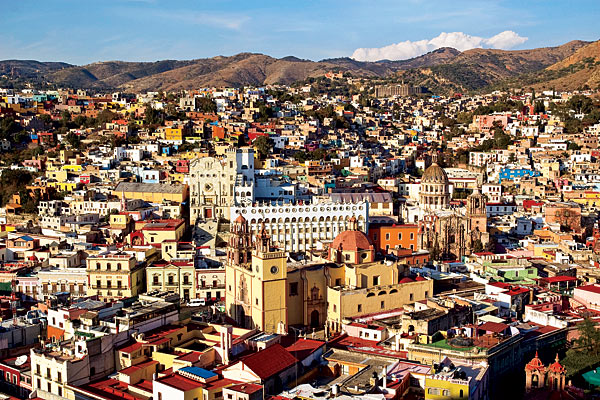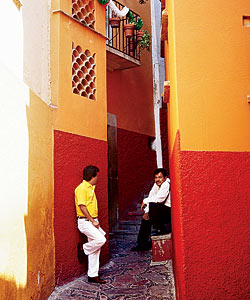
Nestled in a narrow valley, Guanajuato is best explored on foot
DESTINATION Guanajuato, Mexico
DISTANCE FROM CHICAGO 2,000 miles
OUR GUIDE Playwright Tanya Saracho
WHAT SHE LOVES ABOUT GUANAJUATO The cobblestone paths, the mountains, and the vivid street life
Ancient mummies. Passionate kisses. Valiant revolutionaries. Factor in the occasional band of roving madrigal singers, and you have a general outline of the singular allure of Guanajuato, Mexico.
The central Mexican city flanked by the Sierra Madre is also immensely conducive to creativity. “I basically wrote all of Mango Street there. The place is magic,” says the Chicago playwright Tanya Saracho, whose adaptation of Sandra Cisneros’s novel The House on Mango Street was commissioned by Steppenwolf and staged in 2009.
Saracho’s trip began not with magic but under duress.
“Trying to adapt Mango Street, I was stressing on the phone with my dad, just kind of crying, ‘I can’t write, I can’t write, I can’t write,’” she recalls. “I remember telling him if I could just have a month somewhere quiet. And beautiful. If there was only a place where I could just disappear—”
There is such a place, her father interrupted. In fact, she’d been there decades earlier, as a child on a family vacation. Within a week, Saracho was on a plane with her best friend and her sister, heading back to a place she didn’t really remember.
“The first thing you notice, it’s not a beach town,” she says. “It’s mountains. The air is crisp. It’s peaceful. You don’t get spring break in Guanajuato.”
You also don’t get there easily. About 220 miles northwest of Mexico City and 2,000 miles southwest of Chicago, Guanajuato is just about the bull’s-eye center of Mexico. You can’t fly there directly: The closest international airport is Del Bajío Airport, in León, about 20 miles away. Direct flights to León are tough to find. Unless you can hire a private jet, you’ll have to transfer in Dallas (American Airlines), Atlanta (Delta), Houston (United), or Mexico City (Aeromexico); roundtrip flights start at about $500. Even without delays, travelers should plan on spending nearly seven hours in transit—four flying, two laying over, and one driving to Guanajuato from León, either in a rental car or cab. (From León, a cab should cost about $55; Saracho strongly recommends settling the fare before you get in.) The cab is the better plan, since cars are prohibited on many of Guanajuato’s streets.

The Alley of the Kiss
No matter, since the city is eminently walkable. Most of the winding cobblestone paths are centuries old and too narrow to accommodate anything much wider than a bicycle. Every hour, a chorus of bells peals from the Basílica Colegiata de Nuestra Señora de Guanajuato, a magnificent 18th-century cathedral overlooking the town square. In the evening, singers—primarily vocal groups from the University of Guanajuato—stroll through the plaza, offering serenades in exchange for a few pesos.
The square became Saracho’s open-air break room. “All things are revealed in the plaza,” she says. “One day, I spent three full hours people-watching. There was a funeral that had run over at the cathedral and a quinceañera party waiting to get in. So there’s a coffin and a dead man and all these mourners in black, wailing. And then there’s these teenage girls in their huge, puffy party dresses, and they’re crying, too, because they’re missing their quinceañera. My sister kept saying, ‘Let’s go look in the shops. Let’s go look in the museums.’ And I’m like, ‘No. I’m not moving. This is better than a movie.’”
(There actually have been movies made in Guanajuato. The 1972 horror flick El Santo contra las momias de Guanajuato [The Saint Versus the Mummies of Guanajuato], starring the lucha libre wrestler known as El Santo, was filmed in the municipal cemetery.)
“You can’t visit Guanajuato without going to the mummy museum,” says Saracho of the repository of more than 100 preserved remains. The mysteriously intact residents of the Museo de las Momias aren’t the only myth-shrouded creatures in the museums of Guanajuato. The Museo Iconográfico del Quijote is devoted to all things Don Quixote, the impossible dreamer of Miguel de Cervantes’s epic. A few twisting streets from the Don Quixote museum, Saracho stumbled upon the Callejón del Beso (Alley of the Kiss), where, according to local legend, doomed lovers embraced across adjacent balconies.
War stories as well as love stories resonate through Guanajuato. Almost 500 years ago, the Spanish arrived, setting the indigenous people to work mining silver from the arid hills. When Mexico finally achieved independence in 1810, Guanajuato had seen its share of revolutionaries and bloodshed. Saracho walked the cobblestones, taking in their history.
“I’d write for a few hours, and then I’d walk,” she says. “It’s all very low key. Not at all touristy, but kind of spiritual. It made me introspective.”
Back in Chicago, Mango Street opened to positive reviews. Saracho knows she will return to Guanajuato soon, perhaps not on deadline this time. “There’s so much to explore,” she says. “Nothing against resorts or Cancun or Carlos ’n Charlie’s, but Guanajuato is different. If you want history, culture, and peace, it’s perfect.”
ESSENTIAL INFORMATION
Museo Iconográfico del Quijote (Manuel Doblado 1; 473-732-6721, museoiconografico.guanajuato.gob.mx) holds nearly 1,000 art pieces related to Cervantes’s characters Don Quixote and Sancho Panza. Museo de las Momias (Municipal Pantheon Esplanade; 473-732-0639) houses more than 100 human remains preserved without human intervention, some still wearing the shoes and socks in which they were buried. An architectural jewel completed in 1903, Teatro Juárez (Jardín de la Unión; 473-732-0183) is the hub of the city’s annual Cervantes festival in October. Tours offered Tuesday through Sunday. Mexico’s Ministry of Tourism gives an overview of Guanajuato at visitmexico.com.
WHERE TO STAY Casa Estrella de la Valenciana (473-732-1784, mexicaninns.com) sits on a hillside and boasts panoramic views from each of its six rooms. Rates for the upscale boutique hotel, including a full breakfast, start around $200 a night. The Hotel Antiguo Vapor (Galarza 5 Centro Histórico; 473-732-3211, hotelavapor.com) is in the center of the downtown historic district. Rates, including a continental breakfast, range from about $125 to $225 a night.
WHERE TO EAT The family-owned Lindo y Sabroso (Paseo de la Presa 154; 473-731-0529) offers dishes from 40 different regions of Mexico. Ik-Etznab (Sierra de Santa Rosa; 473-102-5146, ik-etznab.com.mx) features innovative fine dining with a regional flair (duck with mole, escolar with arugula pesto). Restorante Truco 7 (Constancia 9 E. Centro Histórico; 473-732-8374, hospederiadeltruco7.com) serves inexpensive regional fare.
Photography: (top) Lisa Predko; (left) John Elk III/Lonely Planet Images; (right) Rhonda Gutenberg/Lonely Planet Images


